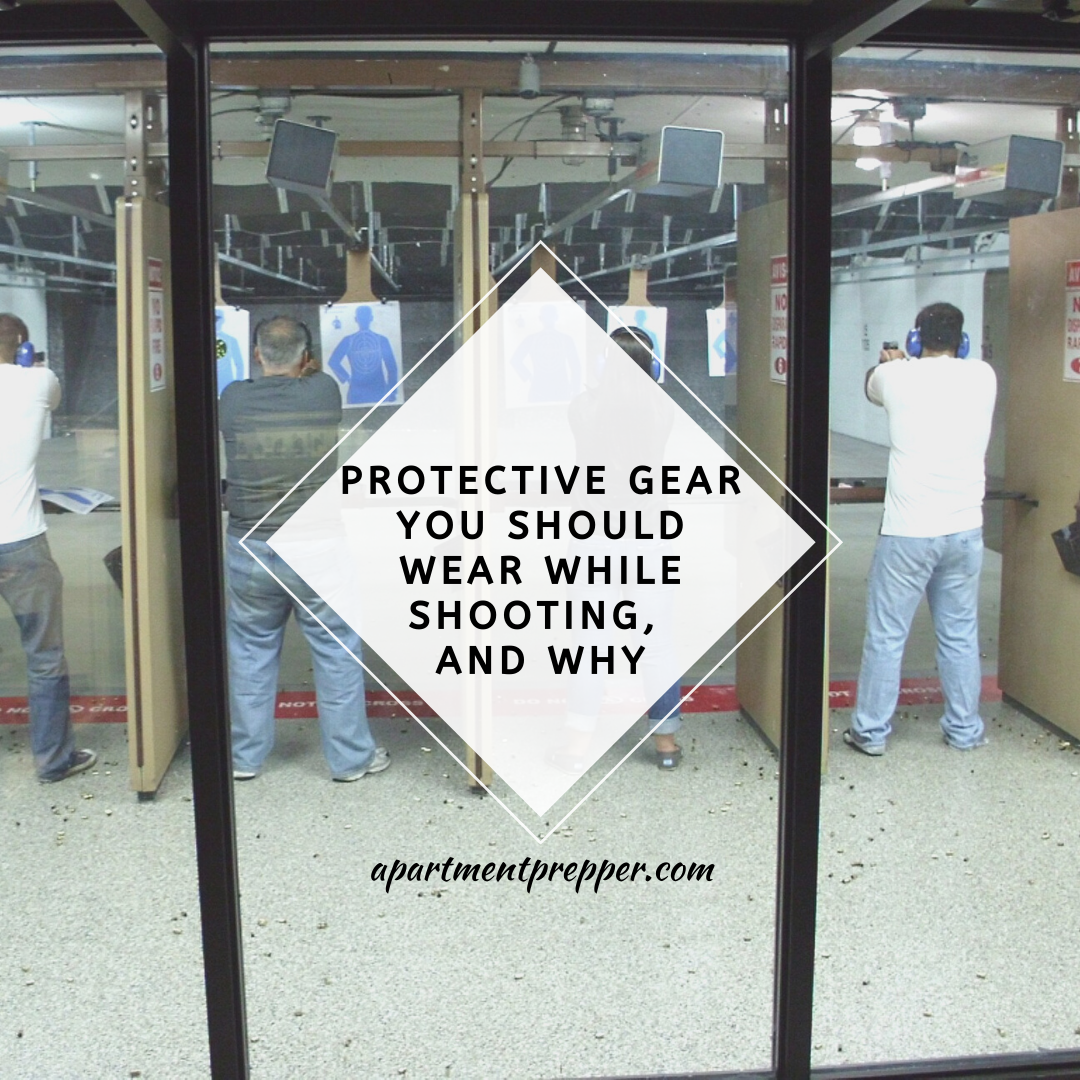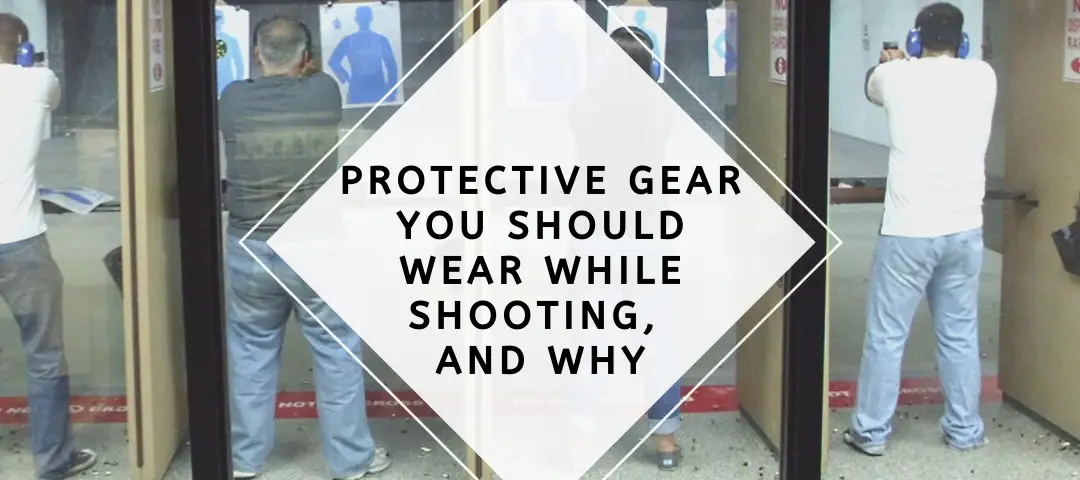Editor’s note: With millions of people buying firearms in the recent months, there are a record number of new gun owners who need to get skilled in using their firearms. In a previous article, we covered safety essentials for first-time gun owners.
Today’s article covers protective gear you’ll need while shooting at the gun range.
Protective Gear You Should Wear While Shooting, and Why
Written by Travis Noonan
March 2020 set a record month for gun sales in America, with over 2.5 million firearms sold across the country. It’s no mystery why: Coronavirus, Covid-19, SARS-CoV-2, which name you want to call it, has spread like wildfire. With it comes social and financial unrest the nation hasn’t seen since the Great Depression. This perfect storm of financial ruin and civil unrest may lead to one thing: Higher rates of theft, burglary, homelessness, and violent crime.
This all spells one need: The need for trained, armed self-defense.
Being confident in armed self-defense means practicing shooting and practicing a lot. While performing quick-draw and dryfire drills at home can get you confident with some of the fundamentals, you need range time. You need to fire live rounds and that means you need the right protective gear, too, which we’re covering today.
Let’s look at the other protective gear, or PPE, you should be wearing whenever shooting firearms.
Ballistic Safety Glasses
While most ranges have backdrops specifically designed to reduce the risk of a ricochet, ballistic glasses (commonly called shooting glasses) are almost always required. If they’re not required at your range, you should invest in them anyway.
Shooting glasses protect against more than just ricochets. If you haven’t been to a range with standard benches and no dividers, you’ll quickly realize just how often spent shell casings – hot brass – can come flying from the table to your left, often at eye-level. While you learn the shooting basics and handling live ammo, safety glasses are critically important. Even veteran shooters wear them.
Buying Glasses: What to Look For (Safety Rating and Color)
Ballistic glasses must receive certain certifications to provide the proper protection against ricochets and high-velocity impacts. The two certifications you should look for when shopping for glasses are Z87.1 (civilian) and MIL-PRF-32432 (military). Both certifications require the lenses to undergo ball-drop impact resistance, high-mass impact, and high-velocity impact tests.
There are other ratings to look for when shopping. These will be listed on the glasses’ frames and denote certain additional protections or lens ratings:
“D” ratings indicate protection against chemicals and dust.
- D3 denotes splash and droplet protection.
- D4 denotes dust protection.
- D5 denotes fine dust protection.
Optional radiation ratings protect against light sources.
- “U” denotes UV light filtration on a scale of 2 to 6.
- “R” denotes infra-red filtration on a scale of 1.3 to 10.
- “L” denotes glare filtration on a scale of 1.3 to 10.
- “V” denotes variable tint.
Lens Color – What’s Best?
In addition to safety, shooting glasses can also provide a unique advantage for visual awareness, thanks to colored lenses.
- Yellow lenses provide high visibility at indoor ranges and they highlight orange targets.
- Orange and purple lenses provide high visibility outdoors and highlight orange targets, too.
- Red lenses are best for urban settings and provide contrast in foggy, cloudy conditions.
- Blue lenses are excellent for green targets.
- Gray and brown lenses act like sunglasses.
To get started, we recommended the Honeywell Genesis glasses by Howard Leight. They’re very affordable and meet military ballistic standards. You can also swap out the clear lenses for other colors based on your shooting environment or range.
Shooting and Proper Hearing Protection
The risk of suffering permanent hearing loss or tinnitus (an annoying, constant ringing in your ears) from shooting without appropriate hearing protection, or “ear pro”, is quite high. Even the lowly .22 LR cartridge can cause hearing loss. For reference, noises above 120 dB (decibels) can cause immediate hearing loss. The average handgun or rifle cartridge reports at least 140 dB or higher (including .22). The common 5.56 NATO cartridge thumps out 165 dB of noise.
This means you must wear ear pro every time you shoot.
Hearing Protection Ratings Explained
Hearing protection is measured by NRRs, or noise-reduction ratings. The higher the NRR, the more decibels are reduced to safer levels. Most hearing protection will be advertised as “30 NRR” or, “28-dB NRR”. Importantly, the NRR is not a one-to-one reduction in total decibels. For example, 30-NRR earmuffs will not reduce the sound of gunfire by 30 decibels. To calculate how much the NRR reduces gunfire in terms of decibels, OSHA (a safety organization responsible for hearing protection standards) says you must subtract 7 dB from the NRR. That means 30-NRR shooting muffs would reduce the volume of gunfire by 23 dB.
Most earmuffs will only reduce gunfire from 140 to 165+ dB down to 120+ dB. That’s still enough to permanently damage your hearing. What does that mean? Doubling up on ear pro by wearing both muffs and earplugs. Earplugs provide similar NRRs, usually 22 to 30. Combining plugs with muffs that afford generally the same protection will get you down to safe noise levels.
Types of Hearing Protection
There are three types of protection to choose: Passive earmuffs, active earmuffs, and earplugs. The latter is a requirement in combination with the two former, so we’ll focus on the differences between passive and active hearing protection.
Passive Hearing Protection
Passive protection is as simple as it gets: The material of the earmuffs provides constant sound reduction. This is usually accomplished with thick foam, rubber, and a hard plastic shell. Passive protection dampens all sound, which can make it difficult to be situationally aware of your surroundings. You may struggle to hold a conversation with your range buddy, or the instructor if you’re attending a class. Passive protection is also the most affordable. A decent pair of muffs that provide high amounts of protection (30 or more NRR) cost less than $30 to $40. Peltor (like their Sport Ultimate Protectors) is one of the most popular options; the company also provides specialized electronic earmuffs for the military, which we’re getting to now.
Electronic Hearing Protection
If you’re willing to spend some extra cash, you can enjoy the protection that earmuffs provide while retaining normal levels of sound and situational awareness when you’re not on the firing line. Electronic muffs provide the same type of noise reduction as passive muffs, but they incorporate directional microphones and a micro-processor with automatic volume controls that filter out dangerous noises – like gunfire – while retaining or even amplifying safe noises, like conversation.
Electronic muffs can vary wildly in price. Entry-level muffs with basic features go for as little as $50, while “professional-grade” options – like the Peltor ComTac IIIs the military uses – can go for as much as $600. Peltor again makes a relatively affordable commercial unit (the Sport Tactical 500) that provides a relatively slim form with an audio jack and sound mixer. They run for around $120.
Earplugs
Earplugs need no introduction. Most earplugs provide an NRR of around 30, with the highest possible rating being 33. No matter how well your passive or electronic muffs perform, always double up with earplugs to ensure you don’t damage your hearing while shooting. Mack’s Maximum Soft Foam Plugs are popular and provide the highest rating.
Shooting Gloves
While gloves aren’t required for shooting, they’re recommended for two reasons. For newer shooters, gloves help to prevent a nasty injury called slide bite. Slide bite occurs when the slide of your handgun railroads the webbing of your hand and the skin on your thumb. It can cause deep lacerations and even require stitches. While you build the proper grip into your muscle memory, gloves serve as a good insulator.
Gloves also help to mitigate recoil, which is the number one inhibitor to mastering the fundamentals of good marksmanship. Being able to overcome the anticipation and natural flinch from recoil will help you cement those best practices into your shooting. As you gain confidence, the gloves can come off.
What to Look for in a Pair of Gloves
You don’t want bulky gloves. Stay away from those burly “knuckle” gloves, too. They can ruin your grip and they don’t provide tactile feedback for your trigger finger. We recommend trying out the PIG Full Dexterity Utility Gloves. They’re very form-fitting and thin but tough. The fingers and palm are grippy, and you can interact with your smart device’s touchscreen. The back of the hand is ventilated and breathable, so you won’t sweat after shooting for extended periods of time.
Quick Summary
Too long, didn’t read? The short n’ sweet:
- You should always wear ear protection and ballistic eye protection when shooting.
- It takes just 120 dB of sound to cause instant hearing loss, which all firearms exceed.
- Always double up on ear protection: Wear earplugs and earmuffs to get the right protection
- Ear protection is measured via Noise Reduction Ratings, called NRR, to quantify decibel reduction.
- Buy earplugs that rate 33 NRR, the highest rating; find earmuffs that are 25 to 30 NRR.
- Gloves will help to improve your shooting skills by reducing recoil and potential injury.
About the Author
Travis is a writer, gunsmith, and military veteran. He contributes to Apartment Prepper and helps run a gunsmithing website for 80% lowers and AR-15 build kits, 80-lower.com.
*******************************************************************
We are an affiliate of Amazon.com, which means we received a small commission if you click through one of our Amazon links when you shop, at totally no cost to you. This helps keep the lights on at the blog. Thanks!
Give the gift of prime:
Image by Chris Flynn from Pixabay


